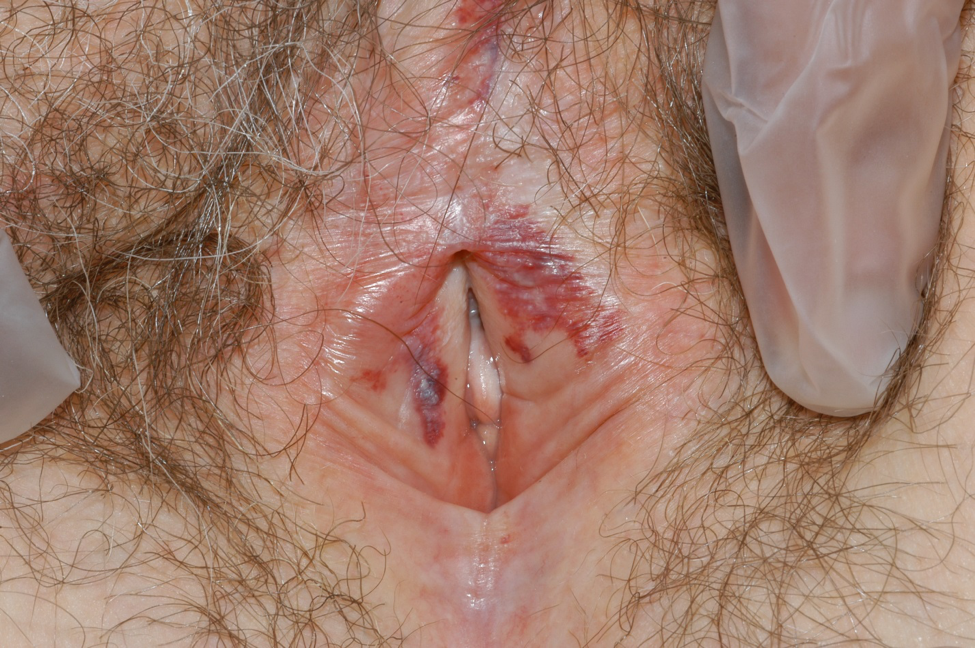Vulvar pruritus in postmenopausal woman
A 62-year-old woman presents for her annual gynecologic exam, stating that she has had a 4-month history of worsening vulvar pruritus. Can you make the correct diagnosis and treatment plan?
Presentation
A 62-year-old woman presents for her annual gynecologic exam, stating that she has had a 4-month history of worsening vulvar pruritus. She has treated herself with over-the-counter yeast creams and cortisone without any relief. The patient states that she has dyspareunia and cannot tolerate intercourse.

Correct Answers
Your most likely diagnosis is: A. Lichen sclerosus
Your treatment plan is: B. Topical steroids
Discussion
Lichen sclerosus is a chronic condition that affects many women. It must be distinguished from other vulvar pruritic conditions such as HSIL of the vulva and vulvar cancer. Lichen sclerosus is mostly a disorder of adult women, but can occasionally be seen in children as well as in men. It is normally found on the genitals and perianal region and often causes itching and soreness. Over time, significant scarring may occur. Typically, there is a wrinkled, cellophane appearance to the skin. As is seen in this patient, purple areas (telangiectasia) may be present.
An initial biopsy should be considered to confirm the diagnosis of lichen sclerosus and rule out other pruritic causes. Treatment is with potent topical steroid ointment, such as clobetasol 0.05% ointment twice daily for a month, followed by once daily for 2 months, followed by maintenance therapy. Maintenance therapy can consist of a class 1 topical steroid such as clobetasol 0.05% ointment twice weekly to 3 times weekly or a mid-dose steroid such as triamcinolone acetonide ointment 0.1% nightly. Patients should be informed that lichen sclerosus can flare intermittently and they may need to repeat the class 1 steroid intermittently. It is helpful to have a provider do vulva checks every 6 to 12 months. Rarely, lichen sclerosus can be associated with differentiated vaginal intraepithelial neoplasia or cancer. Repeat biopsy is recommended if a suspicious area develops.
HSIL of the vulva is most commonly caused by the high-risk types HPV. It can also cause itching. Diagnosis is done with vulvoscopy and directed biopsies. Depending on its location, HSIL is treated in a variety of ways, including laser, topical imiquimod 5%, or excision.
SCC may also be associated with high-risk HPV types (previously discussed) or with lichen sclerosus (as seen in Figure 16) or lichen planus. Up to 5% of women with lichen sclerosus of the vulva develop invasive SCC.

Vulvar SCC
Although vulvar candidiasis can cause vulvar pruritus, that is not the typical appearance. Vulvar candidiasis is often bright red and weepy. Wet mounts and cultures usually reveal pseudo-hyphae. Treatment can be with topical and/or oral fluconazole. Postmenopausal patients with recurrent vulvar candidiasis should be tested for diabetes mellitus.
References
Chi CC, Kirtschig G, Baldo M, et al. Topical interventions for genital lichen sclerosus. Cochrane Library. 7 December 2011; Available at http://onlinelibrary.wiley.com/doi/10.1002/14651858.CD008240.pub2/abstract Accessed July 23, 2017.
Lawrie TA, Nordin A, Chakrabarti M, et al. Medical and surgical interventions for the treatment of usual-type vulval intraepithelial neoplasia.Cochrane Library, 5 January 2016. Available at http://onlinelibrary.wiley.com/doi/10.1002/14651858.CD011837.pub2/full Accessed July 23, 2017.
Ansink A, van der Velden J. Surgical interventions for early squamous cell carcinoma of the vulva. Cochrane Library. 24 April 2000 Available at http://onlinelibrary.wiley.com/doi/10.1002/14651858.CD002036/abstract Accessed July 23, 2017.
ISSVD. Vulvovaginal Candidiasis (Candida, Yeast): Tips for Diagnosis and Treatment. iPhone app Available at https://itunes.apple.com/us/app/vulvovaginal-candidiasis-candida/id1077624993?mt=8 Accessed July 23, 2017
Rising endometriosis rates linked to increased pregnancy complications
May 19th 2024A new study presented at the 2024 ACOG meeting reveals a significant rise in endometriosis among pregnant women over the past 20 years, linking the condition to increased obstetric and neonatal complications.
Read More
Laparoscopic RFA linked to enhanced pregnancy outcomes in uterine fibroid patients
May 18th 2024A recent study presented at the 2024 ACOG Clinical and Scientific Meeting reveals that laparoscopic radiofrequency ablation significantly improves pregnancy outcomes for women with uterine leiomyomas.
Read More
